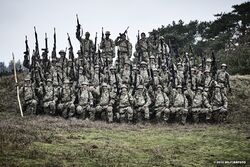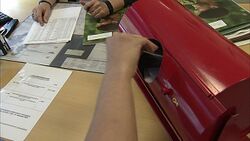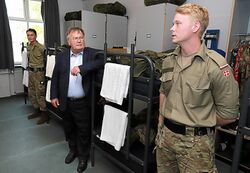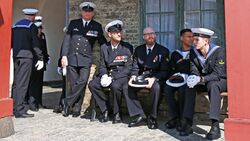Conscription in Sjealand
Conscription in Sjealand, officially known as Duty of Defence (Tynic: Værnepligt) is the institution of mandatory military service in Sjealand. When men and women turn 18 they are summoned to the nearest military establishment where they will draw lots to decide whether or not they must serve. They typically serve nine to sixteen months in the Royal Sjealandic Army, Royal Sjealandic Navy, the Royal Sjealandic Air Force or the Emergency Management Agency, with both genders sharing equal responsibilities. Conscription is laid out in the Constitution of Sjealand, §72 and the Sjealandic Law of Conscription, §3. Every single able-bodied man and woman in Sjealand are obliged to participate in conscription.
Annually around 80,000 men and women complete the service, which gives a series of boons and support in the civilian life. Conscientious objectors may refuse to serve their conscription and instead have to complete 14 months of community service at one of 10 community service centers around Sjealand, though at reduced pay compared to their colleagues in the military and without the boons after service. Foreign citizens may apply to serve conscription in Sjealand, but are required to go through screening services and will not be issued translators.
History
Regulation
According to §72 of the 1828 Sjealandic Constitution, every able-bodied Sjealandic adult has to complete military service
Every person able to bear arms, must contribute to the common defence and security of the country as laid down by law.
— Constitution of Sjealand, §72
The law governing conscription in Sjealand has undergone several revisions since 1828.
Session
Upon their 18th birthday all Sjealandic citizens recieve a message on their digital mailbox, this requires them to fill out a health test for the armed forces. After a screening for any detrimental cases (for example amputees or people with terminal illness) the rest will be put into a group of possible soldiers and will be summoned to attend session at the nearest recruitment station to them. Recruitment stations are typically military bases and installations, but in remote or rural areas of Sjealand the military will typically send a dozen representatives and use a local public building. Summons to session exempts one from attending education, work or other duties on the selected day, and the summoned is allowed free public transportation to and from the selected recruitment station.
It is possible to request a deferrence from session for 5 times should extra-ordinary circumstances prevent the summoned to attend. Failure to attend once without a deferrence warrants a warning and a fine of 500₹. Failure to attend twice warrants a fine of 1500₹. Failure to attend three times results in the summoned being picked up by police and driven to the recruitment station and a possible 3 day prison sentence for pre-emptive desertion.
Once arriving at the recruitment station, the individual will show their printed out summons as well as photo-id. Following this they are led into the recruitment building where every person is issued a more detailed health test that also includes questions about the individuals mental state. Once these are filled out and delivered to the staff the attendees of the days session go through tests in mathematics, tynic and other intelligence tests. When these are finished the attendees watch a series of informational films about conscription and the armed forces.
When this is over a series of doctors call in the attendees for a thorough medical test and grade them on the following scale:
| Grade | Description | Outcome |
|---|---|---|
| Suitable | "Physically fit and without any major health ailments." | "To be enlisted for standard conscription." |
| Limited suitability | "Those whose physical and psychological constitution generally classifies as suitable, may either be allowed to serve standard conscription or administrative military work at the doctors behest." | "To be enlisted for supplemental service or or standard conscription depending on the doctors judgement." |
| Unsuitable | "Those incapable of performing military service due to any disease or mental or physical incompetence." | "To be exempted from military service." |
| Unsuitable at the moment | "Those unable to be graded due to an illness or injury that exempts them at the time but might be suitable at a later date." | "To undergo a follow-up physical examination" within two years. |
Drawing of lots
All individuals, no matter their suitability enter a final office after their physical exam. Here they will draw a lot from a tombola drum, the number on this deciding whether they will have to serve or not. Once a lot has been drawn the individual can wait with opening it and declare their intention to volunteer for conscription, which usually gives various bonuses. After this the lot is opened and numbers below 80,000 are typically conscripted.
A volunteer will, once his lot has been attached to his papers, go into the recruitment sergeants office and will be allowed to apply for any regiment or unit they desire provided there is a need for men in it. Volunteers can be allowed 2 years waiting space to get into their desired unit. Non-volunteers are allowed to either pick three preferred units or negotiate three conditions with the sergeant, for example if one does not want to serve close to their home. Once this has been done the individual will usually recieve mail within 4 months informing them that they are to serve conscription in a select unit, though time and place orders are usually only recieved four months before the service starts.
In the event of ongoing education the conscript can apply for a deferment of their service while they study.
Service
List of service areas
Army
| Area | Name | Location | Serving time |
|---|---|---|---|
| Administrative | Flådestation Frederiksværn | 12 Months |
Air force
Emergency Management Agency
Military and non-military duty
Four months before their service starts, recruits recieve an online mobilization order from their unit. This includes: a welcome from the commanding officer of their battalion, company, camp or base, typically a lieutenant colonel or commander; a ticket giving them free public transportation to their barracks (for some this includes a ferry or plane ticket); a list of what they should pack and instructions on how to order their travel card. Additionally some mobilization orders include practical information about the unit, accommodations and tips for preparing themselves. Conscientious objectors are also notified four months before their community service but recieve less information than their military counterparts as their service is less intensive.
Aspects of military life
Duties
Apart from their standard military training, conscripts also serve a variety of other duties. Throughout their stay at their barracks they take turns manning a number of entrance points to the camp, typically fours conscripts and a seargant per entrance. Their duties include processing any entering the camps as well as patrol duty to off-lying depots and facilities in the general vicinity. Conscripts will, in the case of an emergency, be called upon to provice assistance in various natural or manmade disasters in the vicinity, such as helping set up flood barriers or fighting fires.
In a few camps conscripts still have menial duties such as making food and serving it in the cafeteria. But in almost all camps these services have been taken over by private companies.
Accomodation
Conscripts live in a series of camps spread out across the country, as well as on ships in the case of conscripts on patrol in the navy. Each camp has a series of dedicated barracks for the conscript with its own toilet and bath facilities. All barracks have the toilet and bath facilities divided out to the individual dorms the soldiers live in, except for the conscripts of the Royal Life Guard living at Kastellet in Asgård, who have communal baths and toilets.
Barracks are divided into dorms, each of whom provides accomodation from between 4 and 18 conscripts. Conscripts in these dorms usually develop a tight bond, and each morning after reveille, seargants will control that the dorms have been cleaned by the conscripts.
Leaves of absence
As a basis conscripts are given 1 day off per month served, depending on the unit these will be put into extended weekends spread out across the service, or one long holiday, such as during jul. In certain units, such as the Royal Life Guard, conscripts who have shown extraordinary performance on duty or in the maintenance of their equipment may be awarded a day off should they have been given five commendations in a row. However as these units serve longer conscription it is not a practice common to most units.
Conscripts may be given sick leave or limited service at the discretion of medical personnel without any approval from the conscripts superior. Additionally conscripts may, in special cases such as the death of a loved one or if the conscript is a parent, be awarded special dispensation.
Traditions
In most conscripted units, officers and non-commissioned officers try to forge their soldiers into Soldier-buddies (Soldaterkammerater). This is a tradition within the Sjealandic military, that conscripts are to forge as close bonds to their compatriots and superiors as possible, so to develop the best soldiers possible. According to the government, conscription serves not only to turn conscripts into soldiers, but also to instill discipline and democratic values into them, turning them into adults.
A magazine called The Soldier Soldaten, is issued every week free-of-charge to all conscripts, typically one per dorm. This magazine is written by former conscripts and include reports of events ongoing in the various units, information about foreign militaries especially their conscrips, and tips and guides on how to suceed as a soldier. One of the more famous parts of the magazine is called Sergeant Quotes (Sergentcitater), and consists of humorous, sometimes politically incorrect or rude comments made by sergeants to conscripts such as Rain is like rape, if you can't avoid it, you might as well enjoy it.
Many regiments have their own bands for conscripts with musical talent, such as complete marching bands or just fife and drums. These will march with the conscripts in parades they take part in, playing various marches connected to their units. Most units also offer their conscripts to chance to earn a parachutist badge for a modest fee.
Two of the biggest traditions during Sjealandic conscription are the Gallas and the Homegoing Parade. The galla is held once the conscripts finish their mark-exercise and are held in the host city of the barracks, or, in the case of the Royal Life Guard, in various cities across Sjealand. During these gallas conscripts enjoy three course meals, live music and entertainment, dances such as les lanciers and waltz and large amounts of alcohol. During these conscripts dress in either standard dress uniform or traditional regimental uniforms, though they change into civilian clothings around midnight, as it is considered tasteless to be drunk with the Archkings Monogram on your shoulder.
The Homegoing Parade takes place the day the conscripts are honourably discharged, once all equipment have been given back to the military the conscripts assemble in a parade and their families and loved ones are allowed to gather around the parade square of the camp to watch the discharge. The conscripts will then march in civilian clothing into the parade square and assemble in three rows. Their commanding officer will hold a speech and usually they and the conscripts will shout their units battlecry before the officer shouts As civilians, Dis-missed. It is then tradition for the conscripts to loudly cheer and celebrate their regained freedom.
Boot camp
On the first day recruits arriving at the rail stations closest to their barracks are traditionally picked up in old military lorries by older conscripts who drive large detours playing songs about life in the military on the radio and warning the recruits of the sorrows they face. This is usually the recruits first experience of hazing in the military and when they arrive at the Guard Post of their barracks drill instructors usually divide the recruits into groups of 10-15 who are taken to the central gathering area. Once more during this older conscripts will be laughing and jeering from their windows, one of few breaches of discipline allowed in the military.
In their first week the conscripts are divided into their basic units, typically platoons and squads in the army and air force and decks in the navy. The general training of boot camp varies from unit to unit but in general all conscripts undergo basic training in, parade drills (very important in Sjealandic military culture, especially in the Royal Life Guard, PE, field training (this typically includes 3 preparatory field exercises focusing on various aspects and ending with the Mark-exercise during which the recruits earn their marks and are pushed to their furthest limits), weapons training, first aid, CBRN, signals and communication training, orienteering and basic firefighting. Additionally the navy gives swimming courses and sailing courses and the air force gives basic introduction to aviation.
Mark Exercise

All boot camps in the army and air force end with what is called a Mark Exercise, such as the Kings Journey in the Royal Life Guard. Combining all that conscripts have learnt in their first three field exercises, the five day long mark exercise is designed to pressure the conscripts to their breaking point. Often surviving on little to no food and recieving hardly any sleep the conscripts are forced on long gruelling marches and relentlessly attacked by older conscripts acting as the enemy during the exercise.
The exercise is typically structured to simulate situations in a warzone and many units from the standing army take part in their own regiments mark exercise to help create a sense of realism. In the eighties and nineties a series of accidents happened during mark exercises, leading to the deaths of a total of 15 conscripts. These events caused a ruckus in the military, and since then the units have attempted to take great care of their conscripts, providing quick on the spot medical care and plenty of water, with the last fatality during a mark exercise occuring in 2005 to a heatstroke.
During the last day of the mark exercise the conscripts undergo what is called an Indpassage (in-passage, as they are passing back into the barracks). These usually have unofficial names such as the Kings March in the Royal Life Guard. These are sprints of about 4-5 kilometres through difficult terrain, during which the conscripts must swim across lakes carrying their entire PLCE and weapon and run through ice-cold streams. During these last kilometres older conscripts will walk and run besides the new conscripts, shouting at them, firing blanks and throwing firecrackers around them to stress the conscripts out. At around the 4km mark the conscripts are attacked with tear gas and are required to finish the last 1km wearing gas masks. As they approach the finish line their platoon, company and battalion commanders will be waiting for them, clapping and cheering them on to finish.
When all have finished, their respective units will typically take Hero-photos of them all together to commemmorate the event. Following this the conscripts will march back into their barracks to the tune of local or regimental musicians, while local civilians, barrack staff, older conscripts and professional soldiers stand on the sidewalks cheering and clapping. The day ends with a ceremony during which the conscripts, dressed in their M/70 Dress Uniform recieve a brass or steel mark for their uniform, proving they have faced out of the ranks of recruits and into those of soldiers.
The week following a mark exercise is spent on administrative work, preparing the conscripts for their long service, with the weekend reserved for a galla during which the conscripts bring partners and celebrate with their compatriots.
Long service
During boot camp drill instructors, platoon and squad commanders typically have taken notes of their soldiers, such as aptitudes for marksmanship, leadership or medical training. In the week after the mark exercise, these notes are compiled together and the conscripts are assigned new roles in new units, this time standing combat units. Here they recieve specialised combat training and necessary instructions, such as how to fire a marksmans rifle or how to drive an APC. Thus the conscripts undergo a transformation from where everyone learnt the same, to small specialised roles combining together to form whole new battalions. The training period for their long service varies, but by the end of the long service, should a conscript wish to sign a contract with the military, the conscript may enter into the standing army without any additional courses needed, they are fully educated as soldiers.
In the navy the conscripts are specialized into their roles aboard their assigned ship, and will spend the last two months of their conscription at sea, patrolling the waters around Sjealand, while some conscripts in the air force receive pilots licenses.
In the event of war and the activation of Sjealands total-defence doctrine, conscript units from across Sjealand mobilize at the barracks they recieved their long service training at. Here they gather in their old units, arm themselves and rush out to positions they were assigned the last time they were soldiers. These reactions are trained annually in a one week long mobilization exercise, going on tour between the units so about a third of the reserve is activated every year. Thus the conscript reserves have the newest idea of what their standing orders are and who their unit is. During the last big mobilization exercise in 2012, around 90% of the conscript reserve was mobilized within three days and had already or was ready to enter position.
Number of participants
In 2016 of the around 90,000 conscripts, 65,320 served in the army, 12,200 in the navy, 7,600 in the air force and around 1,500 in the emergency management agency. Of these 52.7% were volunteers, with the lowest percentage of volunteers in the air force at 33% and the highest in the emergency management agency at 72%. The unit with the highest amount of volunteers over all was the Royal Life Guard at 95% volunteers.
Rights
Many rights normally afforded to citizens are voided for conscripts. For example conscripts do not have the right to strike, as doing so would cause them to be punished for mutiny and desertion. As they legally are not working for the ministry of defence, but instead are serving duty, they have no rights to negotiate pay, conditions or training. In addition conscripts are legally bound to serve their conscription unless they declare themselves conscientous objectors, and can not quit their service.
However conscripts are also protected by Sjealandic military law. For most minor offences they are not prosecuted by normal courts, but by the military itself, whose rulings and punishments do not show up on their criminal record (it does however show up on their military discharge). I addition any traffic fines a conscript could recieve while driving a military vehicle are paid for by the military.
While they do not have a union or rights to negotiation, the conscripts together have the Conscription Council (Værnepligtsrådet), which consists of 20 members elected by the spokespersons of each main unit. The Conscription Council collects grievances from all conscripts and presents them to the Ministry of Defence, trying to collaborate with the military in their boths interest. Additionally each platoon up to battalion elect a spokesperson who is their representative with the officers and non-commissioned officers.
Criticism
Civilian
Conscription has been criticised by many in civilian Sjealandic life as out-of-date and for perpetuating involuntary servitude in the name of the state. Especially with the Aldinean Cold War heating up there has been calls from certain parts of Sjealandic politics to either scale down or completely abolish conscription.
Some civilian groups led by former conscripts have been campaigning for greater rights for the conscripts, such as the right to unionize, the right to strike against inhumane conditions and the right drop out, which the Ministry of Defence has denied. Parties directly opposed to, or critical of conscription include De Liberales Liga and Fremskridspartiet.
Military
Some high-ranking officers has criticised conscription as draining too much money away from the armed forces, which could be used on acquiring more modern material or hiring more professional soldiers. Others have questioned the quality of the conscripts in the event of war, citing various examples abroad as a reason why relying on a mass mobilization of conscripts does not adequately provide national defence.





